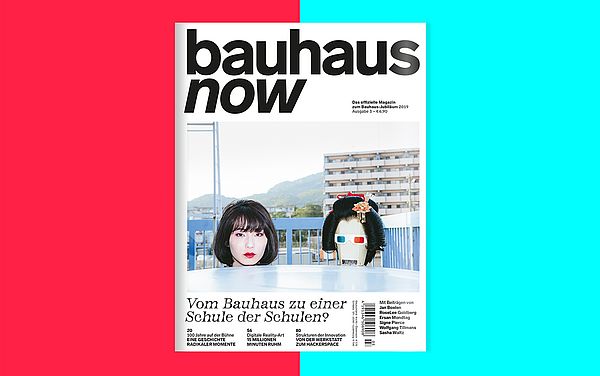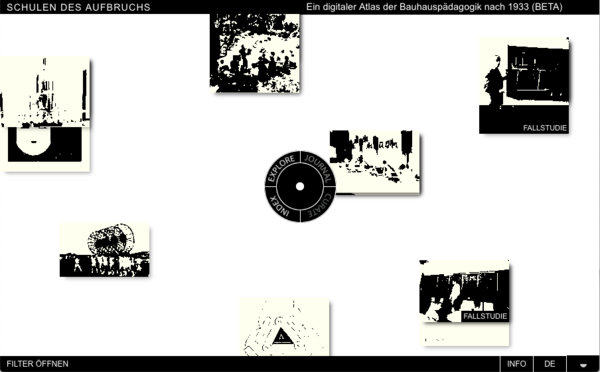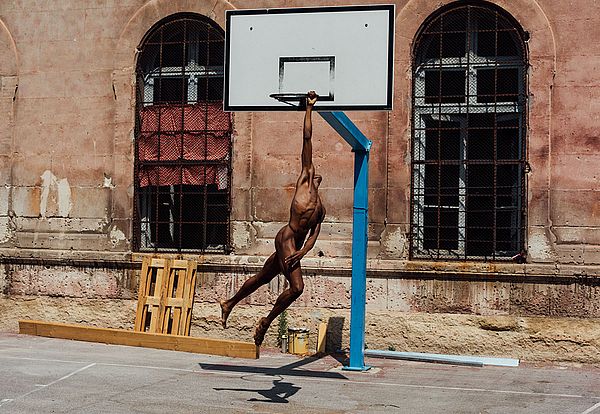A Guideline for Teachers’ Self-education
Performance of Pedagogy
It is enough to make you want to cry, although tears often do alleviate emotional strain: the wisdom of the backwoods and mutterings of the salon still see education as an instrument to align young people with precisely those expectations held by parents, teachers, and employers, on which it must be based. Bazon Brock rejects this—in favor of the Bauhaus.
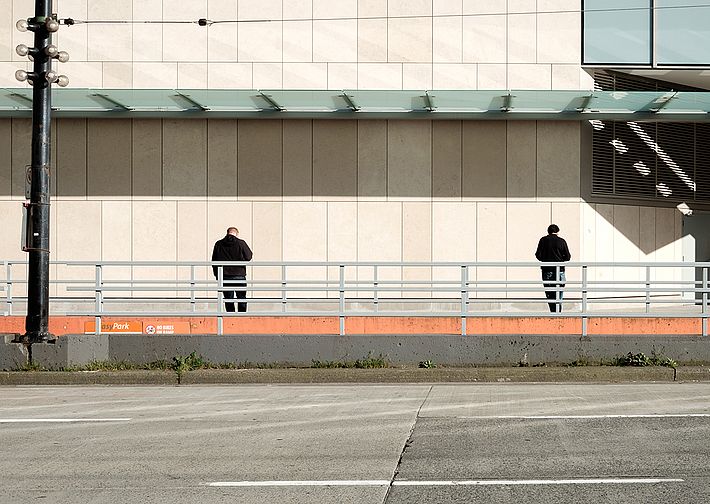
Absatz 1
Of course, everyone self-assuredly professes their contempt for the pedagogy of what Germans call the “Nuremberg funnel,” in which endless knowledge is simply poured into children’s heads. However, in doing so, they miss what is certainly a decisive educational opportunity, namely: becoming filled with enthusiasm and a lust for life through a “holy spirit”—known in this case as pedagogical Eros. Because, according to the notion that the body is like a container which is filled with vital energy (corpus quasi vas), enthusiasm enters into the young mind like a flash of enlightenment. In everyday life, the spirit is holy, as a redeemer that shows us how to master our feelings of abandonment, helplessness and fear of arbitrary powers.
Bazon Brock (Berlin) is Professor Emeritus of Aesthetics and Cultural Communication as well as an artist and art theorist. He also founded the Berlin-based Denkerei—Thinkery with the Office for Work on Insoluble Problems and Measures of Higher Authority.
[Translate to English:] Absatz 2
The early teachers were very often army veterans and village pastors; they were trained to heal the disaster of the Thirty Years’ War with the founding of “fruit-bearing societies” and became examined examiners. In self-assessment, they were to prove themselves in keeping with the model of a doctor’s Hippocratic oath. Beginning with Comenius, elaborate educational theories were seen as guidelines for this civilization of the civilizers, that is, for the instruction of the teachers. In keeping with the new demand that only those who had been examined be allowed to examine, the “leaders of the young” had to assess themselves in order to be able to validly assert their claim to authority as educators. (See also the fear of those giving final secondary school examinations, which are lived out in dreams of no longer being able to pass the exams themselves.)
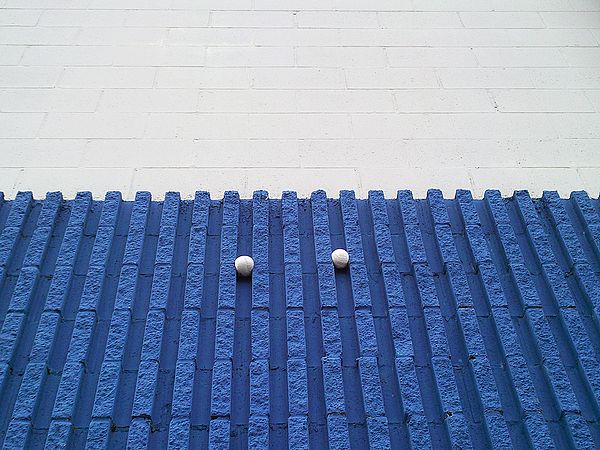
[Translate to English:] Absatz 3 – 4
At least since the introduction of compulsory education, it has been considered necessary to insure that teachers meet a minimum standard of increasing their knowledge as the years of their career pass by. For this purpose, educational theory has placed criteria of assessing self-control at teachers’ disposal, in order to avoid private fantasies and spite based on religious confessions and political partisanship, because these forms of caprice are certainly well-suited to cause the work of teachers to drift into arbitrariness.
Those are the general remarks—and now for their application to the very specific concepts of the Bauhaus. Contrary to the general tendency mentioned above, it seems likely that the majority of the Bauhaus teachers were scarcely trained as teachers; instead, they were practicing artists. While artists have also been awarded professorships at art academies for around three hundred years, they were primarily there not to reflect on pedagogy but to produce art. Training at the academies took place, on the one hand, through the imitation of those who were already able to do what the students were trying to learn and, on the other hand, through obeying a canon of minimum standards regarding precisely this ability based on familiarization.
Craft transforms knowledge
The latter is very often discredited as a sterile formalism of obedience to rules (academicism). This training procedure had been developed over the centuries in crafts organized on the basis of guilds, and it was strictly regulated through tests determining the degree of ability required for journeymen’s or masters’ admittance into the individual guilds. The test givers were themselves tried-and-tested members of the guilds.
Following the humanists’ 15th-century rediscovery of the Augustinian maxim that the work of craftsmen also leads to gains in knowledge (ut pittura poeisis—dog Latin!), the differentiation between implicit knowledge—like that of the crafts—and explicit knowledge—like that of the sciences—was reduced to such an extent that visual artists like Leonardo could be recognized as geniuses in the production of knowledge and, on the other hand, scientists used and continue to use craft-based arts of representation (in medicine, for example, since Vesalius) as a key form of developing knowledge. At least since it became the duty of all scholars to utilize the imaging techniques of electronic media, this convergence of craft and the production of knowledge has been getting ready to acknowledge the visual “fine sciences.”
[Translate to English:] Absatz 1 nach 1 Überschrift
The aim of the Bauhaus concepts of the unity of individual work and teamwork, art and technology, science and craft (see Gropius’s opening address in Ulm in 1955) was the mutual permeation of explicit and implicit knowledge. Those who discover the way in which a positively unbelievable abundance of knowledge implicitly enters into the practices of the crafts will no longer insist on the opposition between manual and mental labor. Around 1770, Kant was still asserting that “we only understand what we ourselves can produce.” However, as Baumgarten had already shown, the work of craftsmen and artists also seemed to be successful through familiarity and without understanding. Indeed, the opposite was true: Understanding what it is we are doing would necessarily prevent us from carrying out the great majority of actions (from making war, committing violence, annihilatory competition, destruction as creation, and using poison to eating unhealthily, etc.).
Bauhütte and Mimicry
If we understood doing that way, we could leave it like that. But that would mean continuing to reduce the causes of our understanding until there was nothing more to understand, because we would no longer do anything. In addition, there is the universally shared experience that we cannot simply do whatever we conceptually postulate, because there is no unequivocal translation of understanding with our mind that equates to grasping with our hand. All work done using a concept changes the concept itself, all the more so when it is the basis of an activity permeated with understanding. In the activity itself, the new emerges as an unavoidable divergence between concept and intuition (Anschauung), between knowledge and activity or between thinking and speaking (generation of aesthetic difference, see www.bazonbrock.de). Our transcending what we have always already known is founded on this difference: This leads to the only important (that is, immanent) transcendence—called Transcendentalism in Kantian terms—in which the self-reflexivity of knowl- edge and action becomes productive.
In the opening program of the Bauhaus, for which Feininger designed his famous woodcut, Gropius makes an appeal based (of all things) on a “premodern” cultural-historical artifact, namely, the Gothic cathedral. For the Bauhaus team, the Bauhütte collectives provided the most compelling example of the power of implicit knowledge, because the master builders of the cathedrals had no scientifically elaborated theory that they could have translated into architectural practice. Instead, they relied on the experience that, in the lucid activity of the crafts, enough implicit knowledge is at work to venture even the most monumental artifacts, while trusting in the power of activity (in spite of some catastrophic collapses among new buildings, which could, however, be explained through shoddy craftsmanship instead of inadequate theoretical insight. This situation was also recently taken into consideration in the context of criminal proceed- ings in connection with the collapse of the highway bridge in Genua, precisely because the project appeared to be entirely safe in the paper form of the design, that is, on the conceptual level).
Thus “Bauhaus” as an up-to-date, modern translation of “Bauhütte,” placed its hopes in the productivity of the aesthetic difference between intuition and concept, thinking and acting. It is worth noting how the ethical difference that is indispensable to aesthetic difference was playfully thematized at the Bauhaus celebrations, namely, as an arbitrary deviation from thinking and communicating, from understanding and action, in lying. In their political orientation, members of the Bauhaus attested to the epistemological concept of nature in mimicry, camouflage, and deception well into the Nazi period: disengaging the relationship between essence and appearance in such a way that the censors would have nothing to latch on to—“conformism as resistance”.
[Translate to English:] Absatz 1 nach Überschrift 3
While there were, in the first years of the Bauhaus, preliminary course teachers, like Johannes Itten, who still believed they could develop their self-concepts of spiritual communities into Bauhaus pedagogy (an error later repeated by Hannes Meyer in his equation of education and work for the party), the cultural-historically important core of the Bauhaus concept is nonetheless to be seen more in the aesthetic of that formation of taste which emerged from England and had been gaining authority in Europe since the Enlightenment of the 18th century (purity, clarity, simplicity). It also lies closer to the poetics of the epic theater and the agitprop of proletarian culture than to an orientation based on the academic discipline of education, even popular education.
Teaching is the performance of pedagogy, with students formed into theorists in action
Bazon Brock
Instructions for self-control
The program defines education as a guideline for the development and self-assessment of artists, who are always in danger of prioritizing their success and effectiveness as instructors over the development of their own artistic work. This is because they could directly recognize and enjoy the effect of their work with students, while the effect of their own artistic work remained largely dependent on the hope that the true qualities of the masters would be recognized at a later date and in another place. Accordingly, mastery consisted in the expert ability to work with an eye on effectiveness and applicability, thus largely erasing the difference between the development of the arts and the power of their effectiveness as applied arts. On the contrary, this meant that the function of the work as an effective force became more important than the work in itself. Bauhaus pedagogy is therefore primarily an evaluation of the intended effect as a function of the immanent artistic logic of the work’s creation: In his 1957 programmatic speech, “The Creative Act,” delivered in Philadelphia, Marcel Duchamp would develop this notion in terms of the relationship between the intentionality of producing, on the one hand, and the response, on the other hand—in the fundamental difference between the sought-after, but ineffectual aim of the artist and the effect that actually wins out in terms of the aesthetic reac- tion, but was not sought by the artist.
Today Bauhaus pedagogy—relayed by way of Marcel Duchamp, Waldorf schools, Black Mountain College, the new founding of the institution in Ulm, the journals Schule Heute with H. K. Ehmer and Ästhetik und Kommunikation with Knödler-Bunte—is represented most ade- quately by the Wuppertal school with Heiner Mühlmann, Ulrich Heinen, Axel Buether, Katja Pfeiffer, Kristian Wolf, and myself. With one of its programs of study (Industrial Design under Odo Klose), Department Five also had a very large effect on Deng’s reforms in China. Ulrich Heinen is fighting for art education’s return to the foundations of design as a transfer of implicit knowledge, seeking to counteract the unproductive, academic self-contemplation of those who are unwilling to engage in artistic work because of their faith in concepts.
[Translate to English:] Absatz 1 – 3 nach Überschrift 4
Since 1965, when I began teaching the subject “non-normative aesthetics” at Hamburg’s Hochschule für bildende Künste (HFBK), I have been proposing that the status of the “theoretical object” be introduced for this realm between art’s production and its reception. This term identifies cognitive tools that can be used to achieve the transfer of implicit into explicit knowledge and vice versa. At that time, the theoretical objects stirred the general interest in the “didacta” expositions of teaching materials, which were based on an entirely new foundation. And large portions of these teaching materials seemed more interesting to us than the majority of the objects exhibited in museums.
The best-known example of the theoretical objects I developed at that time is a two-pack of clothes brushes, which make the abstract scholarly concept of self-reflexivity accessible to everyday understanding. The pair of brushes point to our experience that the functional logic of the brushes necessarily leads to the dirtying of the brushes, through the removal of dust on textiles or brushing hair. Everybody intuitively knows to apply the principle of brushing self-referentially to the brushes themselves, that is, to brush the brushes in order to clean them. A mute, everyday, practical activity like the brushing of brushes is enabled to form a scholarly concept through its generalization: Self-referentiality/self-reflexivity goes far beyond reflexiveness. The everyday world acknowledges scholarly work as a transfer of implicit knowledge into explicit knowledge.
From the Bauhaus to Action Teaching
Since the Second Vatican Council, which began in 1962 and bid farewell to a large part of the Catholic liturgy and antiquated rite of the Mass, contemporary artists have turned to the action-based art form of the performance: a successful transfer of religious practice into artistic practice. Performance was initially seen as just a name that sounded better than “happening” for referring to little action-based pieces. However, in combination with the concept of the environment, which emerged at that time, it was understood that the artistic activity was to be placed within correspondingly defined surroundings. While the happening, particularly in the case of Vostell, Lebel, Schneemann, and Rauschenberg, was still understood within the horizons of Informalism and not on the basis of processual forms defined by the surroundings/environment/setting, the performance oriented the events of the action towards the defined surroundings of its protagonist. Via the space of the viewers in front of the image and the expanded central perspective, this development moved beyond the image as a painting on the wall to the active space of reception; this is the reason why, at Hamburg’s HFBK, I established a class for reception in analogy to the studios for production. Reception as the theoretical work of gaining access to a meaning of the image became the primary form: the meaning of what was happening revealed itself through theoretical activity, that is, active forms of viewing, looking and listening. For the artists, exhibiting became a curatorial task. For the audience, viewing became the Duchampian production of the work.

[Translate to English:] Absatz 2 – Ende Letzte Überschrift
In 1959, parallel to Allan Kaprow, I began introducing the term “action teaching” for this entity—deliberately based on action painting, action music, and action theater. The roots of the latter three, and thus also of the action teaching pieces, lay in Alfred Jarry, the Dadaists, Rod- schenko and the Bauhaus, for example, in Schlemmer’s Triadic Ballet. To summarize, teaching is the performance of pedagogy, with students formed into theorists in action, or: reception realized in the audience’s own activity. In combination, the two of these ideally result in what fills the cultural pages today as a ballet of setting to dance all currently discussed social curiosities in dance theater.
This article was originally published in the third issue of the “bauhaus now” magazine.
